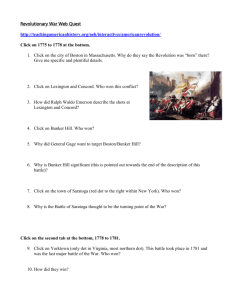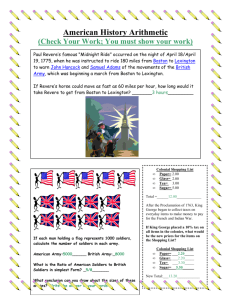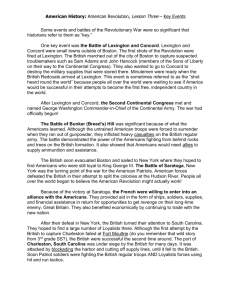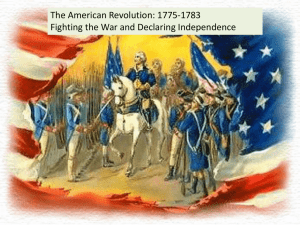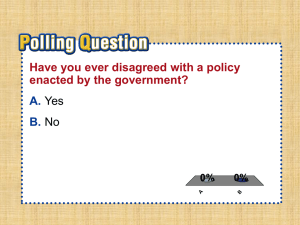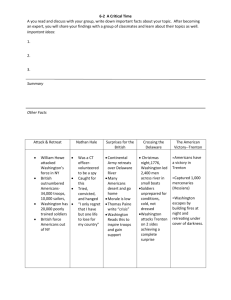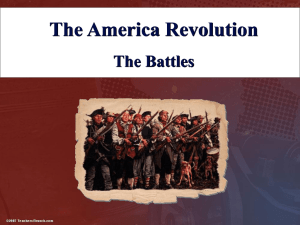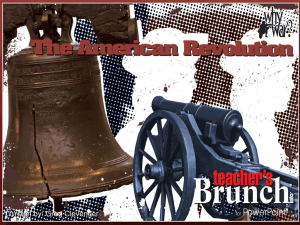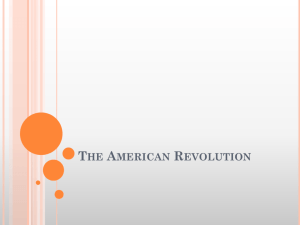American Revolution PPT
advertisement
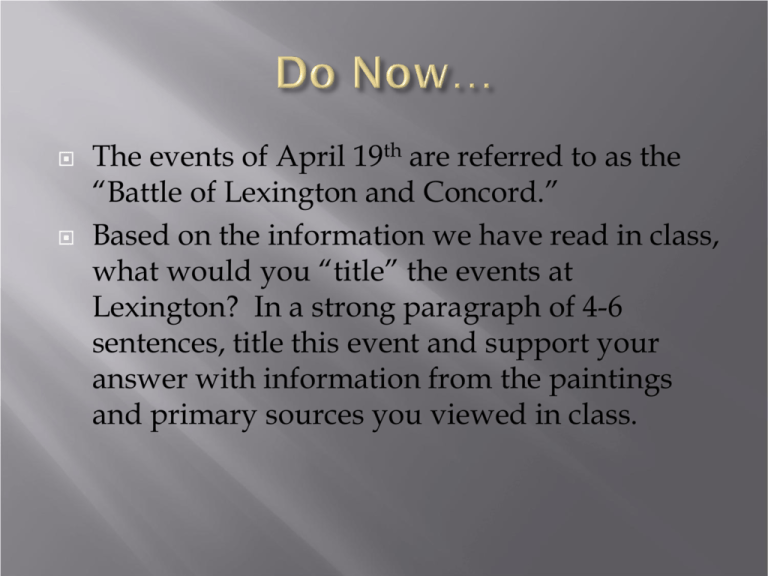
The events of April 19th are referred to as the “Battle of Lexington and Concord.” Based on the information we have read in class, what would you “title” the events at Lexington? In a strong paragraph of 4-6 sentences, title this event and support your answer with information from the paintings and primary sources you viewed in class. Late 1774-1783 Ben Franklin’s famous cartoon Met in Sept. 1774 to form a united response to the Intolerable Acts by all colonies Came from every colony but Georgia: notables: Patrick Henry “Give me liberty or give me death”, George Washington, Samuel Adams, John Adams All colonies agreed upon the following: boycott of British goods, all people to arm themselves and form militias, sent direct letter to King George III requesting representation in Parliament King’s response “The New England governments are in a state of rebellion, blows must decide.” Americans began to call themselves “Patriots” Massachusetts militia stockpiled weapons in Concord (stolen) Late on night of April 18, 1775, British troops left Boston and began to march to Concord to seize weapons (by sea?) Paul Revere, William Dawes, and Dr. Samuel Prescott on horseback warned Patriot leaders such as Sam Adams and John Hancock and militia men in Lexington and Concord Minutemen and British battle on Lexington Green Minuteman Statue Concord, MA April 19, 1775- British reached Lexington and encountered 70 minutemen British officer ordered “Lay down your arms, you damned rebels, and disperse” - at about the same time, a shot was fired (by who?) “the shot heard round the world”- Emerson First deaths- 8 Americans British continued to Concord, stopped at North Bridge by militia On return to Boston, 4000 Patriots had arrived and shot at British from behind houses, trees, and stone walls Considered American victory Revolution had begun ! After Lex. And Con., Congress gathered again in Philadelphia, this time in May 1775 Continued to meet during entire Revolution Most of the same people from 1st Congress Newcomers: Ben Franklin, Thomas Jefferson, John Hancock Nov. 1775- Learned that George III had rejected Olive Branch Petition Influenced by Common Sense, a pamphlet by Thomas Paine, which said it made “common sense” for the Colonies to become independent from GB “’TIS TIME TO PART”- T. Paine July 4, 1776 - Congress approves Dec. of Independence written by? Bunker Hill Monument Charlestown, MA British retreated to Boston; trapped inside city May 1775- Ethan Allen and his Green Mountain Boys captured Fort Ticonderoga June 1775- Battle of Bunker Hill Most fighting actually occurred on Breed’s Hill Patriots, on top of hill, turned back 2 British assaults On 3rd try, British under Gen. William Howe captured Breed’s and Bunker Hill when Americans ran out of ammo On paper, a British victory since they took both hills In reality, Americans suffer 2/3 less casualties Bunker Hill was a tremendous boost of morale and confidence for Americans July 1775- George Washington arrived just outside of Boston, from Philadelphia Had been appointed Commander of Continental Army by 2nd Cont. Congress Oct 1775-March 1776shelled British forces in Boston and ships in Boston Harbor March 17, 1776- Evacuation Day- British leave Boston, retreated to Nova Scotia along with Loyalists (Tories) Parliament authorizes army of 55,000 Includes 30,000 Hessian mercenaries Admiral Richard Howe in charge of fleet—authorized to make peace. Patriots defend New York Important harbor Hudson River—waterway to the interior Miles of coastline dilute Washington’s forces Howe brothers proceed with peace negotiations Rejected by congress British destroy large portions of Washington’s army in a series of battles Forced Washington to retreat to New Jersey Revealed American Army’s lack of training, experience, equipment Because Americans lacked a well-supplied, stable, and experienced army, Washington had to improvise (break war rules) Christmas Night 1776Washington and 2,400 troops sailed across the icy Delaware River from PA into NJ At dawn, they surprise attacked 1,400 Hessians (German mercenaries) and captured them at Trenton A few days later, Washington attacked and took Princeton,NJ These 2 winter battles boosted American morale and convinced more Americans to join the Continental Army Summer 1776-NYC fell into British hands Washington asked for a volunteer to go spy on the British Young Nathan Hale disguised himself as a Dutch schoolmaster As he returned to American lines with info, Hale was captured by British, and hanged for treason “I only regret that I have but one life to lose for my country” -Nathan Hale July 1777- Philadelphia captured2nd Continental Congress flees to Lancaster then York, PA British Gen. John Burgoyne ordered to march south from Canada to NYC to cut off New England from rest of colonies Around Saratoga, Burgoyne’s large army was slowed by felled trees and destroyed stone bridges Attacked by 20,000 strong Patriot force led by Gen. Horatio Gates Outnumbered and suffering heavy casualties, Burgoyne surrendered Saratoga = “Turning Point of War” After Saratoga victory, France openly agreed to join on the side of the Americans (secretly giving $ and arms before Saratoga) France’s Marquis De Lafayette planned battle strategy and led French troops alongside G.W. Polish Engineer Thaddeus Kosciusko helped build effective defenses like forts, bunkers, and trenches German Baron Von Steuben trained Cont. Army at Valley Forge George Rogers Clark used guerilla tactics to secure the Nicknamed the Ohio River in 1779 “Swamp Fox” Francis Marion helped US win 2 Gen. Nathaniel Greene’s battles in SC victories in Carolinas (Cowpens) forced a British retreat towards coastal Virginia in 1781 John Paul Jones 1st US Navy Hero Captured 40 British ships “I have not yet begun to fight!” British army under Lord Cornwallis marched to Yorktown, on the coast, to be re-supplied by British ships Yorktown is on a peninsula between the York and James Rivers Lafayette blockaded land escape from peninsula Washington marched a combined French-American Army from NYC to meet up with Lafayette French Navy blockaded escape by Cornwallis and held back British Navy Escape impossible, Cornwallis surrendered to Washington End of Rev. War 1) 2) 3) 4) 5) Because 4 nations were involved (US, GB, FR, SP) the peace process took nearly 2 yrs. Major Provisions of Treaty: GB recognized independence of the US Northern border between US and British Canada set from NE to Mississippi River, along Great Lakes Mississippi River established as Western boundary between US and Spanish Louisiana, river = free trade US Southern Boundary set with Spanish Florida GB agreed to withdraw all troops from US territory Northwest Territory of US Find 4 Reasons in notes or textbook:Why the US won Rev War?
